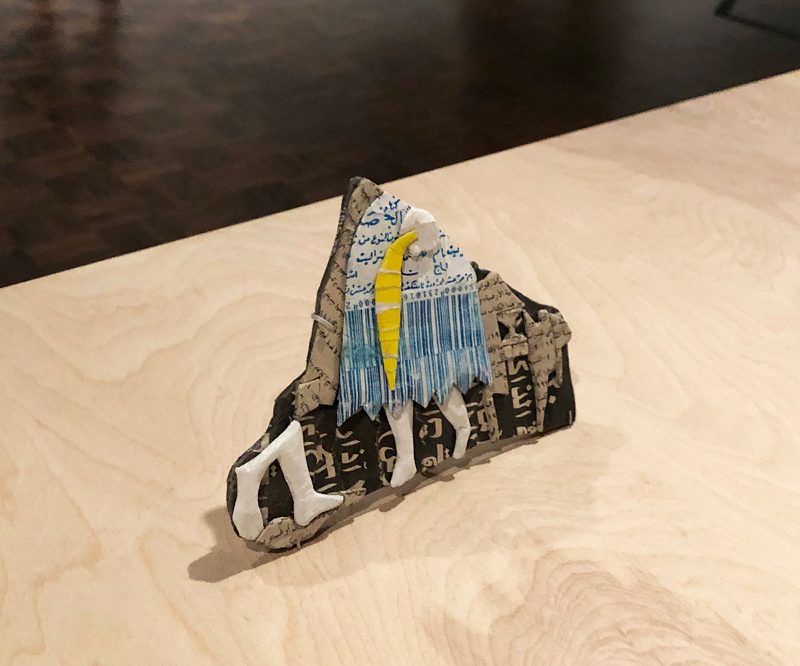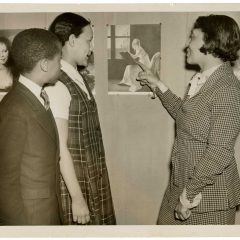Joy Feasley aka @wormwood_and_haze from instagram asks:
The artists removing their work from the Whitney were able to make their work, exhibit it, and make a political statement by removing it in a very political protest of Kanders. We will see how this plays out for their future exhibition opportunities but it would seem they have gotten their cake and eaten too. Michael Rakowitz might be the unfortunate hero, his conscience led the way but will his artwork be forgotten?
For those of you who just got here, I will try to do this in one sentence, with links. This question pertains to the 2019 Whitney Biennial wherein artists were asked (twice. technically.) to protest the exhibit in an effort to remove Warren B. Kanders, Safariland CEO, a company which makes tear gas (among many other items used to militarize police), as Vice Chairman of the Whitney Museum’s board. And even if you don’t know the whole story, artists’ acts of protest against the the ruling class have happened before, will happen again and are happening now.
Empathy, as with being a human, is inherent in art making, hence the artist taking their place against the oppressive (ruling) class – the natural stance for an artist. Unless you’re Jeff Koons. As much I would like to hold up my fellow artists from the past and today, more often than not thru art history artists did not protest, toed the line or painted the equivalent of a subtweet. Can I just say? I’ve written this article on why an artist should make protest art if they want to, cry if they want to, five times already. To name a few; Public Charities are the New Corporate Takeovers, To organize or not organize (an art festival), that is the question, Make Art Not War.
Welcome back. So, no. You will not be getting the contrarian take here, as much as I know it’s cool and appreciate the drama *cough* excuse me I mean discourse – Michael. Rakowitz. Will. Not. Be. Forgotten. Probably. The artist is the art. That’s why political art is so icky. And in terms of the name of an artist being synonymous with the art of an artist, every article to date about the 2019 Whitney Biennial mentions Michael Rakowitz’s name in the opening paragraph. Kanders has resigned as a direct result of artist(s) protesting being in the 2019 Biennial exhibit and Michael Rakowitz was the first artist to say no thank you.
Michael Rakowitz states his reasoning best in an article for The Art Newspaper:
I tried so hard to visualise my work in the biennial as a way to counter the images of tear gas canisters and the wounds they inflict at the border, or any weapon on any body anywhere. But the truth is, it can’t. For as long as Kanders remains on the board, let alone as its vice chairman, my work and the people—and the pain of displacement I address in it—can only be appropriated.
There is an irony on the topic of whether Michael Rakowitz’s work will be forgotten in that his artwork is about forgotten cultures wherein colonization erases cultures. If you feel like heading Uptown to the Whitney’s previous residence at what is now The Met Breuer, Rakowitz currently has works on view there which are recreations of artifacts looted from the National Museum of Iraq in Baghdad after the US invasion in 2003. The recreations are paper mache using commercial packing paper and newspaper from the Middle East. It is a sad sight knowing you are looking at a shadow of an object, yet a beautiful gesture – often the awkward part of looking at political artworks is that they are beautiful. The majority of Rakowitz’s artworks in restoring forgotten cultures are performative, whether it be through food, music or religious ceremony. Rakowitz’s lean-into performance approach brings me to the conclusion that he appreciates the gesture of protest.


An artist that makes artwork about communities probably doesn’t really give a sh*t about the individual, or whether they themselves will be remembered. Let us not overlook that activism is not the work of individuals but of groups (Take Back the Bronx, Decolonize This Place, GULF, BAN, Liberate Tate (more here). Therein lies the contrarian backlash—artist as individual—and institutions that buy into the artist as genius doctrine. Art for so long, as long as it has been written about, is about the individual, the genius. That’s why collective activism makes very little sense for an artist—all of us. We are all indoctrinated through art history (capitalism), to consider ourselves inherently individuals (neoliberals). The art world— collectors, auction houses, galleries, museums—buy in to the individual artist as genius doctrine. The creeping anxiety of death that calls us to spawn is the same motive for making your art—to not be forgotten. You will be forgotten or at least one day…problematic.
Off the top of my head, from the er, 2007, 2006 Whitney Biennial? I mostly remember Zoe Strauss. And that’s because they are an unfortunate hometown hero. The 2017 Whitney Biennial, ironically most people remember Dana Schutz’s painting of Emmet Till—I imagine not the desired outcome of protestors of this work, who wanted the work taken down and in some cases wanted it destroyed. And in 2021, I predict that everyone will only remember Nicole Eisenman’s piece from the 2019 Whitney Biennial. Nicole Eisenman, the MacArthur “genius” artist that broke the millionaire’s back. Wait a minute. Kanders is only a millionaire? Wow. We have a lot of activism ahead of us.

Now I’m about to go off FOR the individual. Nicole Eisenman will be remembered because they protested to have their work withdrawn, but also because “Procession” was (is) the standout piece of the entire show. A grand procession, er, selfie station, poised upon, literally a platform, atop the balcony of the Whitney overlooking Manhattan, and it farts. On the side as part of the piece, a video depicting people farting (via heat sensor camera) in front of a Morris Louis was (is) exceptionally the most on point institutional critique of the 2019 Whit Biennial. Nicole Eisenman, an established artist, MacArthur “genius,” grant winning artist, demanding the Whitney remove their artwork (best in show, er, ticket sales) unless Kanders goes is the gesture that made the crimillionaire (I consider manufacturing tear gas criminal) resign from the board. Nicole Eisenman will not be forgotten.
BUT. BUT if it weren’t for Michael Rakowitz, Decolonize this Place and later Hannah Black, Ciarán Finlayson, and Tobi Haslett’s incredibly moving article “The Tear Gas Biennial,” Nicole Eisenman might have never made their move. And that move by the individual, the genius grant winning artist, was the move. Michael Rakowitz, who is of stature career wise in comparison to Eisenman, did not cause people to bat an eye. Not as dramatic. Likewise, the move by the other seven artists who wanted to remove their work from the Biennial—Korakrit Arunanondchai, Meriem Bennani, Nicholas Galanin, Eddie Arroyo, Christine Sun Kim, Agustina Woodgate, and Forensic Architecture—didn’t make as much of a ripple. By 2021, will you remember all their names?
Without a doubt, Rakowitz missed out on the opportunity to make work for this particular show and perhaps if he did make a popular widely written about artwork in the show, who knows, his protest would have had more impact, as in, Kanders effectively resigning. Rakowitz failed to see the nuance in posturing vs protest, as anyone, a human being (empathetic), might. It takes a certain social intelligence to understand posturing, the win/win move, proven to get results while saving face. Think Goya, a court painter, painting “The Third of May 1808” in 1814, after the Peninsular War. Goya was criticized for continuing to paint for French sympathizers during the Peninsular War, and when Ferdinand VII was restored as king of Spain in 1814, though cordial, Goya and the king were not the best of friends. And today “The Third of May 1808” is revered, remembered, as a powerful homage to resistance.
However, I refer to posturing as I understand it today; the performative act of protesting via the social media timeline predominantly used by the SJW. Posturing, the dark horse of the Medium.com post media writer played out on the tl daily, has made its way into our art world. Posturing is careerist. An A+ strategy for the artist looking to make it in the art world w/o losing their integrity. Posturing is for the “career boon,” as mentioned as such in every 2019 Whitney Biennial protest article. That is until museums start adding “will not remove artwork” to their contracts with artists.
Best,
Surely Forgotten Bottom Beth
The Whitney Biennial, Whitney Museum of American Art, New York, until Sept. 22, 2019. More information here.
Michael Rakowitz’s recreations of the looted Iraqi antiques, part of the Met Museum’s collection, is on view on Floor 2 of the Met Breuer. More here.
Ask Artblog is the essential advice column for all your art life questions. Beth Heinly and Dave Kyu, our Advisors-In-Chief, offer solid advice from life experience and mature opinions on issues. Have a question for Dave or Beth? Email ask@theartblog.org. Or click here to submit a Google form with your questions.









